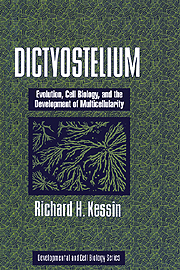Book contents
- Frontmatter
- Contents
- Preface
- 1 A Brief Introduction to Dictyostelium discoideum and its Relatives
- 2 A History of Research on Dictyostelium discoideum
- 3 The Evolutionary Biology of Dictyostelium
- 4 The Genome and Genetics
- 5 Membranes and Organelles of Dictyostelium
- 6 Cell Motility and the Cytoskeleton
- 7 The Transition from Growth to Development: From Starvation to Self-Sustaining cAMP Signal Relay
- 8 Chemotaxis and Aggregation
- 9 Differentiation and Adhesion in the Aggregate
- 10 The Behavior of Cells in the Slug
- 11 Culmination
- 12 Formation and Germination of Spores
- 13 Resources
- References
- Index
- Plate section
12 - Formation and Germination of Spores
Published online by Cambridge University Press: 07 October 2009
- Frontmatter
- Contents
- Preface
- 1 A Brief Introduction to Dictyostelium discoideum and its Relatives
- 2 A History of Research on Dictyostelium discoideum
- 3 The Evolutionary Biology of Dictyostelium
- 4 The Genome and Genetics
- 5 Membranes and Organelles of Dictyostelium
- 6 Cell Motility and the Cytoskeleton
- 7 The Transition from Growth to Development: From Starvation to Self-Sustaining cAMP Signal Relay
- 8 Chemotaxis and Aggregation
- 9 Differentiation and Adhesion in the Aggregate
- 10 The Behavior of Cells in the Slug
- 11 Culmination
- 12 Formation and Germination of Spores
- 13 Resources
- References
- Index
- Plate section
Summary
The fusion of the prespore vesicles (PSVs) with the plasma membrane creates an immature spore. A number of further events must occur before the cell can be assured of protection from desiccation, osmotic shock, or the digestive tracts of soil creatures. The spore proteins, galuran, and cellulose must be organized and cross-linked in such a way that they protect the delicate amoebae within. The formation of the coat, about which we know quite a lot, still presents a number of problems (Lydan and Cotter, 1994; West and Erdos, 1990; West et al., 1996). We know that a number of the prespore proteins and the polysaccharide galuran are synthesized and modified in the early and intermediate stages of the secretory pathway, and then stored in a regulated secretory compartment, the PSV (Srinivasan et al., 2000). We do not know how the proteins of the spore coat interact with cellulose. There are alternative views regarding the extent of pre-assembly of proteins into specific complexes in the PSV. There is no information on how the spore coat is anchored to the plasma membrane. We are beginning to understand the mechanism that the spores use to maintain their dormancy, but new components in these pathways remain to be discovered. We do not know a great deal about how the spores detect the appearance of nutrients and launch the developmental program that leads to germination and the re-establishment of amoeboid life.
- Type
- Chapter
- Information
- DictyosteliumEvolution, Cell Biology, and the Development of Multicellularity, pp. 210 - 222Publisher: Cambridge University PressPrint publication year: 2001



